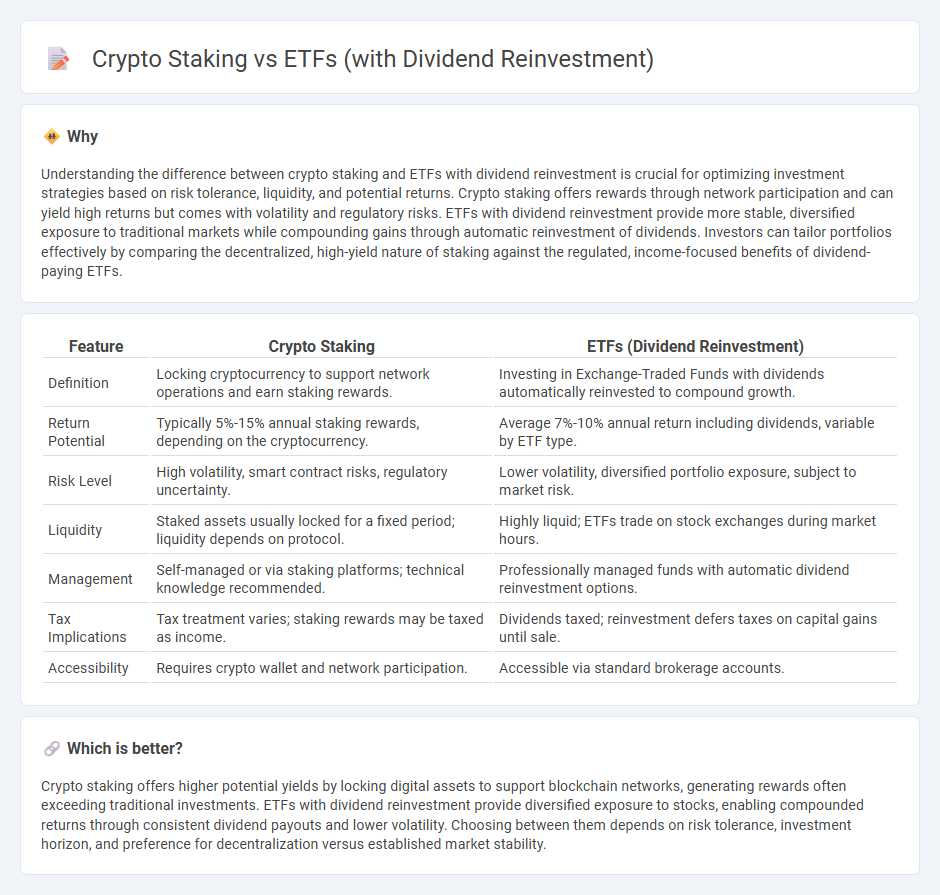
Crypto staking offers investors the opportunity to earn passive income by locking digital assets in blockchain networks, providing rewards based on transaction validation. ETFs with dividend reinvestment focus on traditional markets, allowing investors to receive and automatically reinvest dividends to compound growth in diversified portfolios. Explore the benefits and risks of both to determine the best strategy for your financial goals.
Why it is important
Understanding the difference between crypto staking and ETFs with dividend reinvestment is crucial for optimizing investment strategies based on risk tolerance, liquidity, and potential returns. Crypto staking offers rewards through network participation and can yield high returns but comes with volatility and regulatory risks. ETFs with dividend reinvestment provide more stable, diversified exposure to traditional markets while compounding gains through automatic reinvestment of dividends. Investors can tailor portfolios effectively by comparing the decentralized, high-yield nature of staking against the regulated, income-focused benefits of dividend-paying ETFs.
Comparison Table
| Feature | Crypto Staking | ETFs (Dividend Reinvestment) |
|---|---|---|
| Definition | Locking cryptocurrency to support network operations and earn staking rewards. | Investing in Exchange-Traded Funds with dividends automatically reinvested to compound growth. |
| Return Potential | Typically 5%-15% annual staking rewards, depending on the cryptocurrency. | Average 7%-10% annual return including dividends, variable by ETF type. |
| Risk Level | High volatility, smart contract risks, regulatory uncertainty. | Lower volatility, diversified portfolio exposure, subject to market risk. |
| Liquidity | Staked assets usually locked for a fixed period; liquidity depends on protocol. | Highly liquid; ETFs trade on stock exchanges during market hours. |
| Management | Self-managed or via staking platforms; technical knowledge recommended. | Professionally managed funds with automatic dividend reinvestment options. |
| Tax Implications | Tax treatment varies; staking rewards may be taxed as income. | Dividends taxed; reinvestment defers taxes on capital gains until sale. |
| Accessibility | Requires crypto wallet and network participation. | Accessible via standard brokerage accounts. |
Which is better?
Crypto staking offers higher potential yields by locking digital assets to support blockchain networks, generating rewards often exceeding traditional investments. ETFs with dividend reinvestment provide diversified exposure to stocks, enabling compounded returns through consistent dividend payouts and lower volatility. Choosing between them depends on risk tolerance, investment horizon, and preference for decentralization versus established market stability.
Connection
Crypto staking and ETFs with dividend reinvestment both enhance passive income through asset growth and compounding effects. Staking secures blockchain networks while earning rewards similar to dividend payouts, which, when reinvested in ETFs, amplifies portfolio value over time. This synergy leverages decentralized finance and traditional markets, optimizing investment returns through continuous compounding.
Key Terms
Yield
ETFs with dividend reinvestment offer stable yield through consistent payout distributions and compounding growth, making them attractive for long-term investors seeking moderate risk. Crypto staking yields vary widely by network and token, often providing higher returns but with increased volatility and risk of loss due to market fluctuations or lock-up periods. Explore detailed comparisons of returns and risks to determine the optimal income strategy for your portfolio.
Liquidity
ETFs with dividend reinvestment offer high liquidity through established stock exchanges, allowing investors to buy or sell shares quickly and efficiently. Crypto staking often involves lock-up periods, reducing immediate liquidity but providing potential staking rewards over time. Explore further to understand liquidity implications and optimize your investment strategy.
Risk
ETFs with dividend reinvestment offer lower risk due to diversification across multiple assets and regulatory oversight by financial authorities such as the SEC. Crypto staking involves higher risk, including market volatility, potential security breaches, and protocol-specific vulnerabilities in blockchain networks. Explore detailed risk assessments and strategies to optimize your investment portfolio.
Source and External Links
Dividend Reinvestment Plans (DRIPs) - Charles Schwab - DRIPs automatically reinvest dividends from dividend-paying ETFs into additional shares or fractional shares at no charge, helping compound investment returns easily within brokerage platforms like Schwab.com.
7 Top High-Dividend ETFs by Yield for July 2025 - NerdWallet - High-dividend ETFs such as Invesco KBW Premium Yield Equity REIT ETF (KBWY) offer dividend yields near 9.6%, combining income and potential stability for dividend-focused investors.
Vanguard Brokerage dividend reinvestment program - Vanguard reinvests cash dividends from ETFs back into purchasing more shares on the open market, allocating whole and fractional shares proportionally across client accounts, with transactions reported transparently on statements.
 dowidth.com
dowidth.com